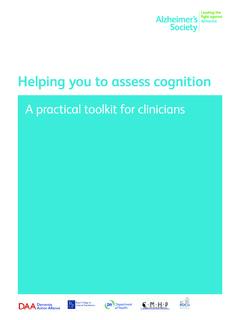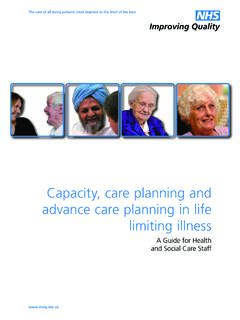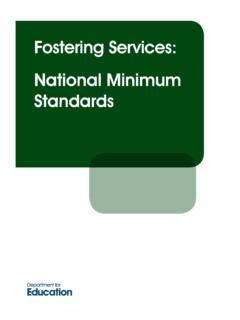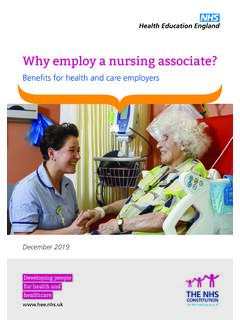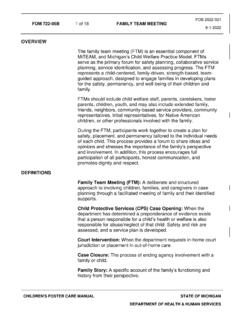Transcription of Writing Good Care Plans - Oxleas
1 1 Foreword People who use health and social care services, should have services that they have been part of choosing, that meet their needs, and are based on the best research and standards. care Plans are the way we plan and agree how someone s health and social needs can be met, and how good health and wellbeing can be supported. They are the most important document that professionals, service users and their families share, and are the means of communicating an approach, a service, or a treatment between all those involved. We believe that this process is so important that it needs proper support and training to help people develop skills and experience in working in partnership to agree a plan . Carolyn Green Executive Director of Nursing and Patient Experience Derbyshire Healthcare NHS Foundation Trust This guide has been put together by the care Coordination Association and Derbyshire Healthcare NHS Foundation Trust in partnership (based on the Trust s award-winning booklet), and is intended to support good practice in care planning .
2 It includes a summary of current policy, standards, guidance and recommendations at the time of Writing , together with guidelines and suggestions about how to write a good care plan . We also look at how someone can plan their own care , and manage their wellbeing. It is the first of a series looking at best practice in the care process. Jaswinder Basi Chair care Coordination Association 2 Contents 1. What is care planning ? 2. care planning Standards 3. Person-centred planning 4. Managing your own care plan 5. Whose care plan is it anyway? 6. What s in a care plan ? 7. Safety planning 8. Involving carers and families 9. Writing good care Plans 10. Involvement 11. Accessibility and communication 12.
3 Choice and capacity 13. Professional approach to care planning 14. Coordination of care Plans 15. Types of care plan 16. References, legislation, policies Terminology: The terms service user or person are used throughout the document to indicate people who use health and social care services, in line with national policy and guidance. Disclaimer: This handbook is guidance only, does not constitute legal advice, and should not be regarded as definitive. Every effort has been made to ensure the accuracy of this guidance; however neither the care Coordination Association nor Derbyshire Healthcare NHS Foundation Trust accept any liability for its accuracy and for any decisions that may be based on it. Individuals and agencies must always check against current legislation, guidelines and local policies.
4 3 1. What is care planning ? This booklet is for anyone who wants to understand how to plan care , and would like to develop skills in care planning . This includes people who use health and social care services and their families and carers, those who work in health and social services, and those who work in partner organisations. To help write better care Plans , it s important first to understand what care Plans are, and what is involved in making a care plan . A care plan A plan that describes in an easy, accessible way the needs of the person, their views, preferences and choices, the resources available, and actions by members of the care team, (including the service user and carer) to meet those needs. It should be put together and agreed with the person through the process of care planning and review.
5 care planning Gathering and sharing stories: the views of all concerned, including the person s, family and carers, and professionals Establishing clear mutual expectations with service users and carers A systematic review of the needs of the person Exploring and discussing choices: to help work out what s most important, and the implications of different choices Goal setting: what do we want to achieve and by when? Action planning : what are we going to do, who is responsible, and when will it be reviewed? Safety: how do we make care as safe as possible? Support: for someone to manage their own health as much as possible 4 A care plan The written record of a plan of action negotiated with the person to meet their health and social needs Something which sets out who is doing what, when, and why (outlines aims, actions and responsibilities)
6 A tool to support the safety of the service user and others A plan which can be used and understood in a crisis by service users, their families and carers and other agencies, as well as colleagues A plan which people feel they own Based on a thorough assessment of need Produced in partnership with all those concerned Coordinated by the most appropriate person, such as a care Coordinator or lead professional Produced in the most appropriate forum Shared effectively with those who are part of it Part of a process that supports care planning under systems such as the care Programme Approach, care and Treatment planning (Wales), Long Term Conditions planning , Health Action planning etc. and meets professional, local and national standards.
7 A care plan is not Bureaucratic exercise, but is an essential element in engaging service users and communicating what the service can and will do, and what responsibilities they, family and carers, and the person concerned will have Wish list, but is a plan of agreed elements of care Contract (although it may form part of a contract in some circumstances), but is a commitment to a course of action from all those involved. 5 What does a good care plan look like to me as the owner of the plan ? What does a good care plan look like to me as a family member? When I was in mental health care , I had a particularly good nurse. She was very good because she didn`t force herself on me, she was friendly, kept things light and helped me develop practical Plans when I wasn`t so well.
8 (patient survey comments) I have found that being included in the whole support package has made things work more smoothly. I can now contact the workers involved when early warning signs are being displayed, and with prompt intervention sometimes prevent hospital admission. Please Remember Ben The care plan is not just about problems, it s a way of managing things you want or need to change in your life. (service user) 6 How are we doing nationally? Why is personalised care so important and how is it demonstrated in care planning ? As a Director of Nursing in an NHS Trust, I want to see that the clinical staff I employ are really starting to change their clinical practice, I would like to be able to open a person s case record to get a real sense of the person in receipt of our services.
9 What they want, how they feel, their treatment goals in the sense of symptom recovery, their health goals and their social recovery. Until we have care Plans that reflect the person, their goals and the clinical staff member s role in enabling the person to meet their goals and achievements, however large and small, we are failing to provide the type of contemporary health service I want my family to receive. We will achieve this, but we all need to embrace the shift in power, from the first contact, in enabling decisions to break the cycle of individuals and families being passive recipients of care . Carolyn Green In response to every question asked in the survey about involvement only 50% to 60% were completely positive about being involved in their own care .
10 This means that only: 56% of people responding were definitely involved as much as they wanted to be in agreeing what care they received 61% definitely felt that decisions were made together by them and the person they saw. CQC Community Mental Health Survey 2015 7 2. care planning Standards Standards for care planning come from a number of sources, but the national CCA standard is: A care plan is a written record of the agreed care and treatment plan for an individual ( care Standards Handbook CCA 2014) National Standards for care Plans include: The care Quality Commission s (CQC) Essential Standards of Quality and Safety , Outcome 4: care and welfare of people who use services: People should get safe and appropriate care that meets their needs and supports their rights.



